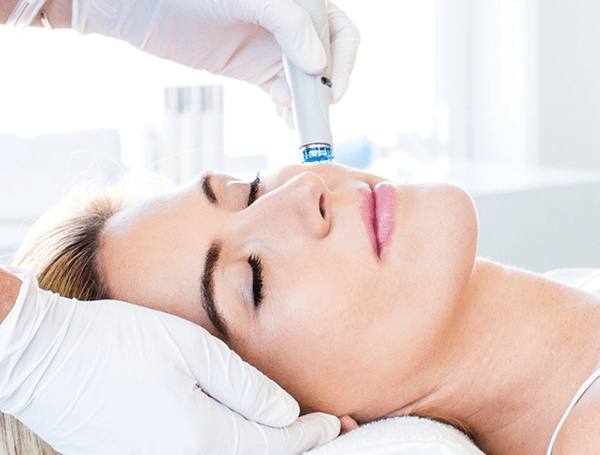
15 Aug Was ist HydraFacial und wie funktioniert es?

Does HydraFacial work?
HydraFacial is a patented skin treatment available in medical and dermatological offices. It is also sometimes referred to as „hydrodermabrasion“ because it is a microdermabrasion-like exfoliant that is paired with moisturizing serums.
Known for its three-step process, the HydraFacial thoroughly cleanses, exfoliates and hydrates your skin. This professional procedure can help treat a variety of skin conditions including acne, skin dryness and wrinkles.
The non-invasive procedure is similar in principle to a normal facial you can get at a spa, but it is said to produce far better results. This is achieved through a device that is used on your skin to do a thorough cleansing and exfoliation while delivering serums tailored to your skin type.
If you’re curious about whether a HydraFacial is worth the hype, read on to learn more about its potential benefits, side effects, and how it compares to similar treatments.
HydraFacial benefits
A HydraFacial treatment is said to help improve overall skin texture, color, and appearance. This is due to the deep scrub, which cleanses your pores, removes debris, and allows for better penetration of facial serums that are tailored to your skin type.

HydraFacial for blackheads
Dead skin cells also contribute to blackheads. This non-inflammatory type of acne can benefit from the same exfoliation and extraction methods used in the HydraFacial.
HydraFacial for rosacea
It can be difficult to find cosmetic treatments that are safe enough for this sensitive skin condition. While more research is needed to demonstrate the safety and effectiveness of the HydraFacial for rosacea, one study found that similar techniques may benefit papulopustular rosacea.
HydraFacial for anti aging problems
A small study trusted source of 20 women found that those who received HydraFacial treatments had greater decreases in the signs of aging than those who only used serum. The effects included reduced pore size, reduced hyperpigmentation and reduced fine lines.
HydraFacial side effects and precautions
While the HydraFacial treatment is supposed to be free of complications, you may feel slight pressure from the device during the procedure. In contrast to other cosmetic treatments, the HydraFacial is not supposed to cause pain or redness.
However, you should avoid this procedure if you have an active rash, such as: B. in connection with a rosacea flare-up.
Is HydraFacial Safe During Pregnancy?
It is best to ask a doctor before undergoing any aesthetic procedures, including the HydraFacial, during pregnancy. A 2017 review found that while many cosmetic treatments are safe, there aren’t enough clinical studies to confirm this.
Can a HydraFacia oil cause an outbreak?
In theory, a HydraFacial was designed to combat excess sebum (oil) and dead skin cells that can lead to breakouts. The treatment can also help clear up any blemishes during skin cleansing that may appear after a deep exfoliation.
Before treatment, let your doctor know if you have extremely sensitive skin or are allergic to ingredients that can cause your skin to break out after treatment. And get in touch with them if breakouts occur after a HydraFacial.
How does the HydraFacial treatment work ?
A HydraFacial is performed by either a licensed beautician or a dermatologist. The procedure consists of three parts:
- Your esthetician will use a vortex-like wand against your skin to remove dirt and oil from deep within your pores. They also use an exfoliator to exfoliate and renew your skin.
- Your esthetician will use a vacuum-like attachment on the wand to remove dirt from your pores.
- Your esthetician will use a pen-like attachment to apply a moisturizing serum with antioxidants.
A HydraFacial treatment is sometimes followed by other skin care treatments such as dermal fillers or light therapy. These are considered optional and are not part of the HydraFacial treatment.
HydraFacial before and after
After a HydraFacial, you may notice smoother, more radiant skin, possibly with a more even skin tone. Results should be seen immediately with no visible sign of irritation.

HydraFacial aftertreatment
Each HydraFacial session lasts less than an hour with no downtime required. Unlike more intense procedures like chemical peels, you can resume normal activities immediately.
While you shouldn’t notice any redness or peeling after your session, it’s still best not to do any exfoliation for the first few days after a HydraFacial treatment.
How Often Should You Repeat a HydraFacial Treatment?
The frequency of HydraFacial sessions depends on your skin type and the recommendations of your provider.

A esthetician or dermatologist can help determine the right number of sessions based on your skin condition and goals.
HydraFacial vs. Microdermabrasion
Like a HydraFacial, microdermabrasion exfoliates your skin. The main difference is that this type of small crystal peel is best for fine lines, wrinkles, age spots, and acne scars. Serums are also not used in microdermabrasion.
Dermal Infusion vs. HydraFacial
Dermal infusion has technology and benefits similar to a HydraFacial. Both are 3-in-1 procedures that cleanse, exfoliate, and deliver serums tailored to your skin problems. In contrast to a HydraFacial, the dermal infusion can then lead to redness and irritation.
HydraFacial vs. high frequency therapy
Radiofrequency therapy (RF) uses thermal energy in deep skin tissues to increase cell turnover and collagen production. Overall, this can lead to firmer and smoother skin. RF can also help treat acne scars.
While both HydraFacial and RF therapy treat signs of aging, RF does not involve an exfoliant or serum. RF can cause redness after each session.
distance
The HydraFacial can through its 3-in-1-cleaning, peeling and moisture process help to treat a variety of skin problems in a session. Talk to a dermatologist about which cosmetic treatments are best for your specific concerns.

